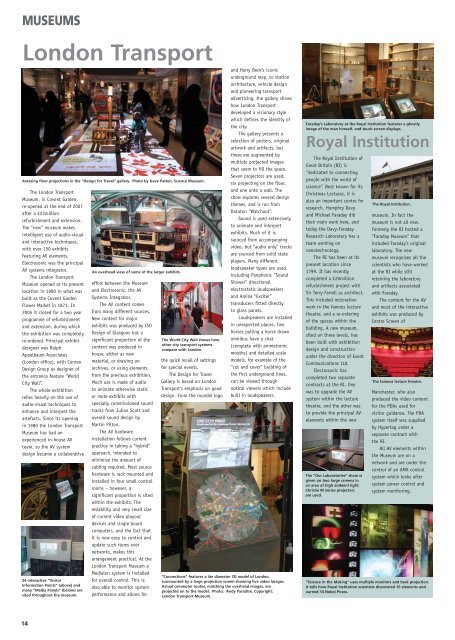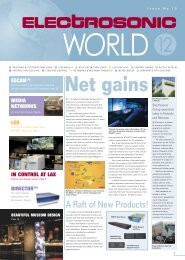45 Years of Solutions - Electrosonic
45 Years of Solutions - Electrosonic
45 Years of Solutions - Electrosonic
Create successful ePaper yourself
Turn your PDF publications into a flip-book with our unique Google optimized e-Paper software.
MUSEUMS<br />
London Transport<br />
Amazing floor projections in the “Design for Travel” gallery. Photo by Dave Patten, Science Museum.<br />
The London Transport<br />
Museum, in Covent Garden,<br />
re-opened at the end <strong>of</strong> 2007<br />
after a £22million<br />
refurbishment and extension.<br />
The “new” museum makes<br />
intelligent use <strong>of</strong> audio-visual<br />
and interactive techniques,<br />
with over 150 exhibits<br />
featuring AV elements.<br />
<strong>Electrosonic</strong> was the principal<br />
AV systems integrator.<br />
The London Transport<br />
Museum opened at its present<br />
location in 1980 in what was<br />
built as the Covent Garden<br />
Flower Market in 1871. In<br />
2005 it closed for a two year<br />
programme <strong>of</strong> refurbishment<br />
and extension, during which<br />
the exhibition was completely<br />
re-ordered. Principal exhibit<br />
designer was Ralph<br />
Appelbaum Associates<br />
(London <strong>of</strong>fice), with Conran<br />
Design Group as designer <strong>of</strong><br />
the entrance feature “World<br />
City Wall”.<br />
The whole exhibition<br />
relies heavily on the use <strong>of</strong><br />
audio-visual techniques to<br />
enhance and interpret the<br />
artefacts. Since its opening<br />
in 1980 the London Transport<br />
Museum has had an<br />
experienced in-house AV<br />
team, so the AV system<br />
design became a collaborative<br />
24 interactive “Visitor<br />
Information Points” (above) and<br />
many “Media Panels” (below) are<br />
sited throughout the museum.<br />
14<br />
An overhead view <strong>of</strong> some <strong>of</strong> the larger exhibits.<br />
effort between the Museum<br />
and <strong>Electrosonic</strong>, the AV<br />
Systems Integrator.<br />
The AV content comes<br />
from many different sources.<br />
New content for major<br />
exhibits was produced by ISO<br />
Design <strong>of</strong> Glasgow; but a<br />
significant proportion <strong>of</strong> the<br />
content was produced in<br />
house, either as new<br />
material, or drawing on<br />
archives, or using elements<br />
from the previous exhibition.<br />
Much use is made <strong>of</strong> audio<br />
to animate otherwise static<br />
or mute exhibits with<br />
specially commissioned sound<br />
tracks from Julian Scott and<br />
overall sound design by<br />
Martin Pilton.<br />
The AV hardware<br />
installation follows current<br />
practice in taking a “hybrid”<br />
approach, intended to<br />
minimize the amount <strong>of</strong><br />
cabling required. Most source<br />
hardware is rack mounted and<br />
installed in four small control<br />
rooms – however, a<br />
significant proportion is sited<br />
within the exhibits. The<br />
reliability and very small size<br />
<strong>of</strong> current video playout<br />
devices and single board<br />
computers, and the fact that<br />
it is now easy to control and<br />
update such items over<br />
networks, makes this<br />
arrangement practical. At the<br />
London Transport Museum a<br />
Medialon system is installed<br />
for overall control. This is<br />
also able to monitor system<br />
performance and allows for<br />
The World City Wall shows how<br />
other city transport systems<br />
compare with London.<br />
the quick recall <strong>of</strong> settings<br />
for special events.<br />
The Design for Travel<br />
Gallery is based on London<br />
Transport’s emphasis on good<br />
design. From the roundel logo<br />
and Harry Beck’s iconic<br />
underground map, to station<br />
architecture, vehicle design<br />
and pioneering transport<br />
advertising, the gallery shows<br />
how London Transport<br />
developed a visionary style<br />
which defines the identity <strong>of</strong><br />
the city.<br />
The gallery presents a<br />
selection <strong>of</strong> posters, original<br />
artwork and artifacts, but<br />
these are augmented by<br />
multiple projected images<br />
that seem to fill the space.<br />
Seven projectors are used,<br />
six projecting on the floor,<br />
and one onto a wall. The<br />
show explores several design<br />
themes, and is run from<br />
Dataton “Watchout”.<br />
Sound is used extensively<br />
to animate and interpret<br />
exhibits. Much <strong>of</strong> it is<br />
sourced from accompanying<br />
video, but “audio only” tracks<br />
are sourced from solid state<br />
players. Many different<br />
loudspeaker types are used,<br />
including Panphonic “Sound<br />
Shower” directional<br />
electrostatic loudspeakers<br />
and Amina “Exciter”<br />
transducers fitted directly<br />
to glass panels.<br />
Loudspeakers are installed<br />
in unexpected places. Two<br />
horses pulling a horse drawn<br />
omnibus have a chat<br />
(complete with animatronic<br />
mouths) and detailed scale<br />
models, for example <strong>of</strong> the<br />
“cut and cover” building <strong>of</strong><br />
the first underground lines,<br />
can be viewed through<br />
optical viewers which include<br />
built in loudspeakers.<br />
“Connections” features a 4m diameter 3D model <strong>of</strong> London,<br />
surmounted by a large projection screen showing live video images.<br />
Actual commuter routes, matching the overhead images, are<br />
projected on to the model. Photo: Andy Paradise. Copyright:<br />
London Transport Museum.<br />
Faraday’s Laboratory at the Royal Institution features a ghostly<br />
image <strong>of</strong> the man himself, and touch screen displays.<br />
Royal Institution<br />
The Royal Institution <strong>of</strong><br />
Great Britain (RI) is<br />
“dedicated to connecting<br />
people with the world <strong>of</strong><br />
science”. Best known for its<br />
Christmas Lectures, it is<br />
also an important centre for<br />
research. Humphry Davy<br />
and Michael Faraday did<br />
their main work here, and<br />
today the Davy-Faraday<br />
Research Laboratory has a<br />
team working on<br />
nanotechnology.<br />
The RI has been at its<br />
present location since<br />
1799. It has recently<br />
completed a £20million<br />
refurbishment project with<br />
Sir Terry Farrell as architect.<br />
This included restoration<br />
work in the famous lecture<br />
theatre, and a re-ordering<br />
<strong>of</strong> the spaces within the<br />
building. A new museum,<br />
sited on three levels, has<br />
been built with exhibition<br />
design and construction<br />
under the direction <strong>of</strong> Event<br />
Communications Ltd.<br />
<strong>Electrosonic</strong> has<br />
completed two separate<br />
contracts at the RI. One<br />
was to upgrade the AV<br />
system within the lecture<br />
theatre, and the other was<br />
to provide the principal AV<br />
elements within the new<br />
The “Our Laboratories” show is<br />
given on two large screens in<br />
an area <strong>of</strong> high ambient light.<br />
Christie M Series projectors<br />
are used.<br />
The Royal Institution.<br />
museum. In fact the<br />
museum is not all new.<br />
Formerly the RI hosted a<br />
“Faraday Museum” that<br />
included Faraday’s original<br />
laboratory. The new<br />
museum recognizes all the<br />
scientists who have worked<br />
at the RI while still<br />
retaining the laboratory<br />
and artifacts associated<br />
with Faraday.<br />
The content for the AV<br />
and most <strong>of</strong> the interactive<br />
exhibits was produced by<br />
Centre Screen <strong>of</strong><br />
The famous lecture theatre.<br />
Manchester, who also<br />
produced the video content<br />
for the PDAs used for<br />
visitor guidance. The PDA<br />
system itself was supplied<br />
by Hypertag under a<br />
separate contract with<br />
the RI.<br />
All AV elements within<br />
the Museum are on a<br />
network and are under the<br />
control <strong>of</strong> an AMX control<br />
system which looks after<br />
system power control and<br />
system monitoring.<br />
“Science in the Making” uses multiple monitors and back projection.<br />
It tells how Royal Institution scientists discovered 10 elements and<br />
earned 14 Nobel Prizes.



